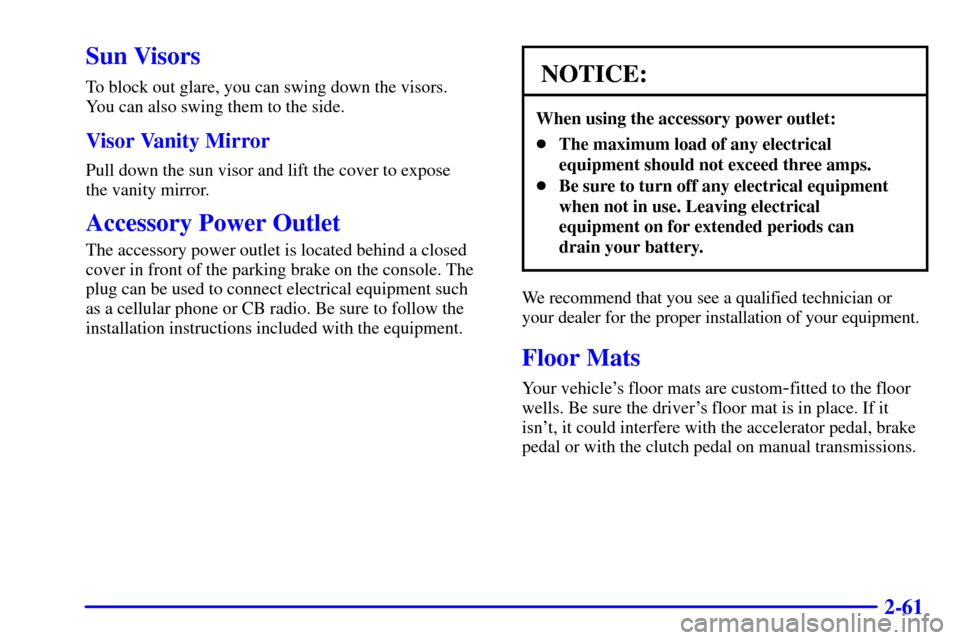Page 4 of 357
Table of Contents
Keys and Door Locks
Remote Keyless Entry (RKE) System
Hatch
Automatic Transmission (If Equipped)
Manual Transmission Operation (If Equipped)
Parking Brake
Windows
Tilt Wheel
Turn Signal/Multifunction LeverWindshield Wipers
Cruise Control
Interior and Exterior Lamps
Mirrors
Storage Compartments
Cargo Cover
Accessory Power Outlet
Instrument Panel, Warning Lights and Gages Seats and Seat Controls
Safety BeltsAir Bag System
Child Restraints
Section
1
Section
2
Seats and Restraint Systems
Features and Controls
ii
Page 58 of 357

2-
2-1
Section 2 Features and Controls
Here you can learn about the many standard and optional features on your vehicle, and information on starting,
shifting and braking. Also explained are the instrument panel and the warning systems that tell you if everything is
working properly
-- and what to do if you have a problem.
2
-2 Keys
2
-4 Door Locks
2
-6 Keyless Entry System (If Equipped)
2
-11 Hatch
2
-13 Theft
2
-14 Content Theft-Deterrent/Alarm
System (Option)
2
-17 PASS-Key� II
2
-25 New Vehicle ªBreak-Inº
2
-25 Ignition Positions
2
-27 Starting Your Engine
2
-30 Engine Coolant Heater (Canada Only)
2
-32 Automatic Transmission Operation
2
-36 Manual Transmission Operation
2
-39 Parking Brake
2
-41 Shifting Into PARK (P)
(Automatic Transmission Only)
2
-42 Shifting Out of PARK (P)
(Automatic Transmission)2
-43 Parking Your Vehicle (Manual Transmission)
2
-43 Parking Over Things That Burn
2
-44 Engine Exhaust
2
-44 Running Your Engine While You're Parked
(Automatic Transmission)
2
-45 Limited-Slip Rear Axle
2
-45 Windows
2
-47 Tilt Wheel
2
-47 Turn Signal/Multifunction Lever
2
-52 Exterior Lamps
2
-55 Interior Lamps
2
-57 Mirrors
2
-58 Storage Compartments
2
-62 T-Top Roof Panels (Option)
2
-69 Convertible Top (If Equipped)
2
-76 The Instrument Panel -- Your
Information System
2
-80 Warning Lights, Gages and Indicators
Page 112 of 357
2-55
Interior Lamps
Instrument Panel Brightness Control
The thumbwheel controls the brightness of your
instrument panel lights. Move the thumbwheel to
brighten or dim the lights. If you move the thumbwheel
all the way up, your courtesy lamps will come on.
Courtesy Lamps
When either door is opened, several interior lamps go
on. These lamps are courtesy lamps. They make it easier
for you to enter and leave your vehicle.
Courtesy lamps include two map lamps on the inside
rearview mirror and other lamps throughout the interior
of your vehicle.
To prevent battery rundown, your interior lamps will be
disabled about 10 minutes after the ignition is turned to
OFF. The 10
-minute timer will be restarted if you do
any of the following:
�Turn the ignition on.
�Open either door.
�Press any button on your remote keyless entry
transmitter (if equipped).
�Turn the interior lamp switch from off to on.
�Open the hatch.
Page 113 of 357

2-56 Delayed Illumination
With delayed illumination, the courtesy lamps will
come on and stay on for 25 seconds after you enter
the vehicle and close the door. They will also stay on
for five seconds after you exit the vehicle and close the
doors. Delayed illumination will be shortened if the
ignition is turned to RUN or if the power locks are
activated. To turn this feature on or off, see ªFeature
Customizationº in the Index.
Exit Lighting
With exit lighting, the interior lamps will come on when
you remove the key from the ignition to help you see
while exiting the vehicle. To turn this feature on or off,
see ªFeature Customizationº in the Index.
Front Map Lamps
Your inside rearview mirror includes two map lamps.
Each lamp has its own switch. Use the switch closest to
the lamp to turn it on. The lamps will also come on
when a door is opened.
Retained Accessory Power (RAP)
Your vehicle is equipped with a Retained Accessory
Power (RAP). It allows certain features on your vehicle
to continue to work up to 10 minutes after the ignition
key is turned to OFF.
Your convertible top, power windows, power mirrors
and audio system will work when the ignition key is in
RUN or ACC. Once the key is turned from RUN to
OFF, these features will continue to work for up to
10 minutes or until either door is opened.
Your power door unlock and remote hatch release
features will work when the ignition key is in RUN or
ACC, or if either door is open. Once the key is turned
to OFF, these features will continue to work for up to
10 minutes. If either door is open and the ignition key
is off, these features will continue to work until both
doors have been closed for about 30 seconds or until
the theft
-deterrent system arms. At that time, both the
power door unlock and remote hatch release features
will be disabled to enhance the security of the vehicle.
The power door lock function will work at all times
except when lockout prevention is enabled. See
ªLockout Preventionº in the Index.
Page 114 of 357
2-57
Mirrors
Inside Day/Night Rearview Mirror
An inside rearview mirror is attached to your windshield.
The mirror has pivots so that you can adjust it.
You can adjust the mirror for day or night driving. Pull
the tab for night driving to reduce glare. Push the tab for
daytime driving.
Outside Manual Adjustable Mirror
Adjust the passenger's side outside mirror by hand so
that you can see a little of the side of your vehicle when
you are sitting in a comfortable driving position.
Manual Remote Control Mirror
Adjust the driver's side outside mirror with the lever
located on the door. Adjust the mirror so that you can
just see the side of your vehicle when you are sitting in
a comfortable driving position.
Power Remote Control Mirrors (If Equipped)
The power mirror control is located on the driver's door.
To adjust either mirror, turn the selector switch to L (left)
or R (right). Then use the control to adjust the mirror.
Page 115 of 357
2-58 Convex Outside Mirror
Your passenger's side mirror is convex. A convex
mirror's surface is curved so you can see more from
the driver's seat.
CAUTION:
A convex mirror can make things (like other
vehicles) look farther away than they really are.
If you cut too sharply into the right lane, you
could hit a vehicle on your right. Check your
inside mirror or glance over your shoulder
before changing lanes.
Storage Compartments
Glove Box
To open the glove box, lift up on the lever. Use your
door key to lock or unlock it.
Front Console
To use the storage area, push the button in located
on the driver's side of the console and pull up on the
console cover.
Cassette and Compact Disc Storage
You have a storage area for cassette tapes and compact
discs in your console.
Page 118 of 357

2-61
Sun Visors
To block out glare, you can swing down the visors.
You can also swing them to the side.
Visor Vanity Mirror
Pull down the sun visor and lift the cover to expose
the vanity mirror.
Accessory Power Outlet
The accessory power outlet is located behind a closed
cover in front of the parking brake on the console. The
plug can be used to connect electrical equipment such
as a cellular phone or CB radio. Be sure to follow the
installation instructions included with the equipment.
NOTICE:
When using the accessory power outlet:
�The maximum load of any electrical
equipment should not exceed three amps.
�Be sure to turn off any electrical equipment
when not in use. Leaving electrical
equipment on for extended periods can
drain your battery.
We recommend that you see a qualified technician or
your dealer for the proper installation of your equipment.
Floor Mats
Your vehicle's floor mats are custom-fitted to the floor
wells. Be sure the driver's floor mat is in place. If it
isn't, it could interfere with the accelerator pedal, brake
pedal or with the clutch pedal on manual transmissions.
Page 191 of 357

4-14
�Do not get too close to the vehicle you want to
pass while you're awaiting an opportunity. For
one thing, following too closely reduces your area
of vision, especially if you're following a larger
vehicle. Also, you won't have adequate space if the
vehicle ahead suddenly slows or stops. Keep back
a reasonable distance.
�When it looks like a chance to pass is coming up,
start to accelerate but stay in the right lane and
don't get too close. Time your move so you will be
increasing speed as the time comes to move into the
other lane. If the way is clear to pass, you will have a
ªrunning startº that more than makes up for the
distance you would lose by dropping back. And if
something happens to cause you to cancel your pass,
you need only slow down and drop back again and
wait for another opportunity.
�If other cars are lined up to pass a slow vehicle, wait
your turn. But take care that someone isn't trying to
pass you as you pull out to pass the slow vehicle.
Remember to glance over your shoulder and check
the blind spot.�Check your mirrors, glance over your shoulder, and
start your left lane change signal before moving out
of the right lane to pass. When you are far enough
ahead of the passed vehicle to see its front in your
inside mirror, activate your right lane change signal
and move back into the right lane. (Remember that
your right outside mirror is convex. The vehicle you
just passed may seem to be farther away from you
than it really is.)
�Try not to pass more than one vehicle at a time
on two
-lane roads. Reconsider before passing the
next vehicle.
�Don't overtake a slowly moving vehicle too rapidly.
Even though the brake lamps are not flashing, it may
be slowing down or starting to turn.
�If you're being passed, make it easy for the
following driver to get ahead of you. Perhaps
you can ease a little to the right.